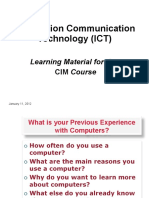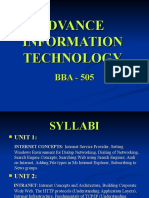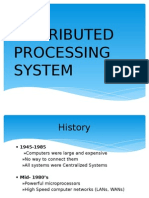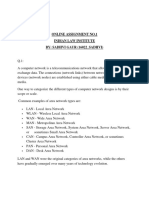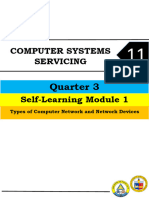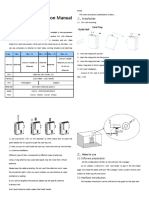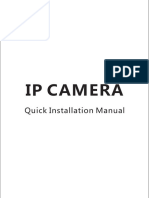MODULE - 2
Information
Technology
Concepts
1
�IT infrastructure
Includes:
Computing platforms
Telecommunication services
Data management services
Application software services
Physical facilities management
IT management services
IT standards services
IT education services
IT research and development services
2
�IT infrastructure
Evolution
Electronic accounting machine era – 1930-1950
General purpose mainframe and minicomputer era –
1959 to present
Personal computer era – 1981 to present
Client/server era – 1983 to present
Enterprise internet computing era – 1992 to present
3
�Components
Hardware & Software
Data resources
Telecommunication Networks
Internet and related topics
Programming Languages
4
�COMPUTER HARDWARE
5
� Computer Hardware
• Types of Computer Systems
• Microcomputer systems
• Personal computers, PDA’s, workstations etc.
• Midrange systems
• Network or Web servers, Multi-user systems etc.
• Mainframe systems
• Enterprise systems, Super servers, Transaction
Processors etc.
6
� Peripherals
•Monitors
•Printers
•Scanners
•Hard Disk Drives
•CD & DVD Drives
•Backup Systems
7
� Input Technologies
•Pointing Devices
•Pen based Computing
•Speech Recognition System
•Optical scanning
•Magnetic stripe
•Smart Cards
8
� Output Technologies
•Video Output
•Printed Output
•Storage
• Magnetic Disks
• Floppy disks
• Hard disk drives
• Magnetic Tape
• Optical Disks
9
�COMPUTER SOFTWARE
Software is the general term for
various kinds of programs used
to operate and manipulate
computers and related devices.
10
�Overview of Computer Software
11
� Types of software
•Application Software: performs information processing tasks for end
users.
• General purpose application programs
• Application specific programs (custom software)
•System Software: manages and supports operations of computer
systems and networks.
• System management programs.
• System development programs.
12
� Interface
13
� Application Software
Business application software
Software suites
Web browsers
Electronic mail & Instant messaging
Word processing
DTP (Desktop Publishing)
Electronic spreadsheets
Presentation graphics
Personal information managers
Groupware
14
� System software
•System management programs:
•System development program:
15
� System management programs:
Programs that manage the hardware, software, network and
data resources of computer systems during the execution of
information processing jobs of the user.
Eg.: Operating system, DBMS etc.
16
� System development program:
Programs that help users develop information system programs
and procedures and prepare user programs for computer
processing.
Eg.: Programming language translators and editors, CASE
(computer aided software engineering)
17
� Operating Systems
-- an integrated system of programs that manages the
operations of the CPU, controls the input/output and
storage resources and activities of the computer system,
and provides various support services as the computer
executes the application programs of users.
18
�Operating System functions
19
� System management Programs
Microsoft Windows
Unix
Linux
Mac OS X
20
�Programming Languages
Machine Language
Assembler Language
High level Language
Fourth – generation Language
Object oriented Language
21
� Programming Languages
Web languages and services
HTML
XML
Java
Programming software
Language Translator programs
CASE
22
� MANAGING DATA
RESOURCES
23
�Data Resource Management
-- a managerial activity that applies information systems
technology and management tools to the task of
managing an organization’s data resources.
24
�Foundation Data Concepts
Bit: Smallest unit of data; binary digit (0,1)
Byte: Group of bits that represents a single character
Character: A single alphabet, numeric or a symbol.
Field: Group of words or a complete number.
Record: Group of related fields
File: Group of records of same type
Database: Group of related files
25
� Database
File
Record
Field
Data
26
�Database Structures
Hierarchical Structure
Network Structure
Relational Structure
Multidimensional Structure
Object – Oriented Structure
27
� Hierarchical Structure
•Organizes data in a tree-like
structure
•Supports one-to-many parent-
child relationships
•Prevalent in large legacy systems
28
� Network Structure
•Depicts data logically
as many-to-many
relationships
29
�Disadvantages of hierarchical and network
structure
Outdated
Less flexible compared to RDBMS
Lack support for ad-hoc and English language-like
queries
30
� Relational Structure
DeptNo Dname Dloc Dmgr Eno Ename Etitle Esalary DeptNo
.
Dept A Emp1 Dept A
Dept B Emp Dept B
2
Dept C
: Dept C
:
:
:
:
:
:
:
:
:
31
�Multidimensional Database
32
� Object Oriented Structure
Inheritance Inheritance
33
�Database Development
34
�Disadvantages of Database
Insufficient data base expertise
Higher data processing costs
Increased hardware and software needs
Data security and integrity
35
� TELECOMMUNICATION
NETWORKS
Exchange of information in any form (voice, data, images, audio, video) over
networks.
36
�Telecommunications:
Communication of information by electronic means
Includes digital data transmission as well as voice
transmission
37
�Functions of Telecommunication Systems
Transmit information
Establish interface between sender and the receiver
Route messages along most efficient paths
Perform elementary processing of information
Perform editorial tasks on data
Convert message speed or format
Control flow of information
38
� Network Topologies
Star Network: All computers and other devices are connected
to a central host computer.
Bus Network: Links a number of computers by a single circuit.
Ring Network: All computers are linked by a closed loop.
39
� A Star Network Topology
40
� A Bus Network Topology
41
� A Ring Network Topology
42
� LAN
Local Area Network: It is a digital communication system
interconnecting a large number of computers and other
peripheral devices within a limited geographical area.
Require their own dedicated channels
Encompass a limited distance
43
� LAN
44
�Wide Area Network
Span large geographical distance
Consist of variety of cable, satellite, and microwave
technologies
Switched lines, dedicated lines
MAN
45
�INTERNET, INTRANET
AND EXTRANET
46
�Internet
The Internet is the world's largest computer network.
It is a collection of interconnected networks all freely
exchanging information.
It is an ad hoc linkage of many networks that adhere to basic
standards.
The Internet has beginnings with ARPANET, a project started
by the U.S. Department of Defense in 1969.
Internet is the network of networks spread throughout the
world.
ISP
47
�Functions of Internet
Communication
Information retrieval
World wide web services
48
�Uses
Surf
E-mail
Discuss
Publish
Buy & sell
Download
Compute
Other uses
49
�Benefits to organization
Generate new revenue from online sales
Reduce transaction costs through online sales and customer support
Attract new customers via web marketing, advertising & online sales
Increase the loyalty of existing customers via improves web
customer service and support
Develop new web based markets and distribution channels for
existing products
Develop new information based products accessible on the web
50
�Problems in internet applications
Security problems
Technological problems
Legal problems
Traditional internet culture
51
�Intranet
An intranet is an internal corporate network built using Internet and
World Wide Web standards and products.
It is used by the employees of the organization to gain access to
corporate information.
An intranet is an inexpensive yet powerful alternative to other forms
of internal communications.
To address security problems, organizations require authorized users
to have an id name and password to access information.
It also uses encryptions and firewalls.
52
�Intranet – business value
Communication & Collaboration
Web publishing
Business operations and management
Intranet portal management
53
�Extranet
An extranet is a network that links selected resources of
the intranet of a company with its customers, suppliers,
or other business partners.
It is built based on Web technologies.
It is a private network accessible through public
infrastructure.
Authentication and privacy are critical on an extranet so
that information is protected.
54








